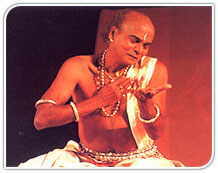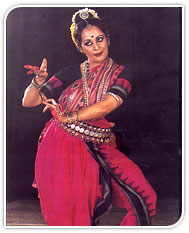Dances of India: Odissi
 A
dance form born in Orissa, manifested in temple sculptures from 2nd
Century BC, practised and enriched by the Devadasis or maharis (as the
temple dancing girls are called in Orissa).
A
dance form born in Orissa, manifested in temple sculptures from 2nd
Century BC, practised and enriched by the Devadasis or maharis (as the
temple dancing girls are called in Orissa).
With the
construction of the Jagannath temple in Puri in the 12th century, the
practice of dedicating maharis in the service of the temple was initiated;
it continues to this day.
At once sensuous and spiritual, it has
the ability to portray erotic sentiments in a deeply reverential manner.
Odissi is a highly stylized dance with tribhanga or three-bend
attitude of Hindu sculpture The bhava or feeling is chaste and orthodox,
with flashes of heightened dramatisation.
 The
accompanying music is pure and classical, with graces of both the
Hindustani and the Carnatic ystems.
The
accompanying music is pure and classical, with graces of both the
Hindustani and the Carnatic ystems.
The instruments
traditionally used are the mandala-drums, gini-small cymbals and the
flute.
Odissi has been restored to its rightful place only in
the last few decades with tireless work by the Gurus like Pankaj Charan
and Deba Prasad Das, Keluchara Mohapatra and Mayadhar Raut; and the
dancers.
 A
dance form born in Orissa, manifested in temple sculptures from 2nd
Century BC, practised and enriched by the Devadasis or maharis (as the
temple dancing girls are called in Orissa).
A
dance form born in Orissa, manifested in temple sculptures from 2nd
Century BC, practised and enriched by the Devadasis or maharis (as the
temple dancing girls are called in Orissa).  The
accompanying music is pure and classical, with graces of both the
Hindustani and the Carnatic ystems.
The
accompanying music is pure and classical, with graces of both the
Hindustani and the Carnatic ystems.